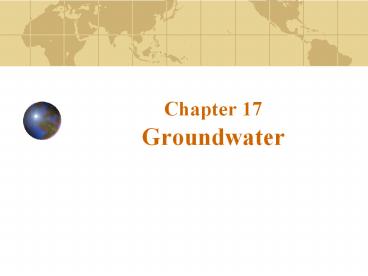Chapter 17 Groundwater - PowerPoint PPT Presentation
Title:
Chapter 17 Groundwater
Description:
Groundwater is the largest reservoir of fresh water that is readily available to ... Composed of dripstone (travertine) Calcite deposited as dripping water evaporates ... – PowerPoint PPT presentation
Number of Views:86
Avg rating:3.0/5.0
Title: Chapter 17 Groundwater
1
Chapter 17 Groundwater
2
Importance of groundwater
- Groundwater is water found in the pores of soil
and sediment, plus narrow fractures in bedrock - Groundwater is the largest reservoir of fresh
water that is readily available to humans
3
Distribution of groundwater
- Zone of saturation - The pore spaces are filled
with water - Zone of aeration - The pore spaces are filled
with air. - Water table the upper limit of the zone of
saturation
4
Distribution of Groundwater
5
The water table
- Interaction between groundwater and streams
- Constitutes a basic link in the hydrologic cycle
- Three types of interactions
- Gaining streams gain water from the inflow of
groundwater through the streambed - Losing streams lose water to the groundwater
system by outflow through the streambed - A combination of the first two a stream gains
in some sections and loses in other areas
6
Gaining and losing streams
7
Factors influencing the storage and movement of
groundwater
- Permeability the ability of a material to
transmit a fluid - Aquitard an impermeable layer that hinders or
prevents water movement (such as clay) - Aquifer permeable rock strata or sediment that
transmits groundwater freely (such as sands and
gravels)
8
Movement of groundwater
- The movement of groundwater is measured directly
using - Various dyes
- Carbon-14
9
Features associated with groundwater
- Springs
- Occur where the water table intersects Earths
surface - Natural outflow of groundwater
- Can be caused by an aquitard creating a localized
zone of saturation which is called a perched
water table
10
Springs may result from a perched water table
11
Features associated with groundwater
- Hot springs
- Water is 6-9oC warmer than the mean annual air
temperature of the locality - The water for most hot springs is heated by
cooling of igneous rock
12
Features associated with groundwater
- Geysers
- Intermittent hot springs
- Water erupts with great force
- Occur where extensive underground chambers exist
within hot igneous rock - Groundwater heats, expands, changes to steam, and
erupts
13
(No Transcript)
14
Distribution of hot springs and geysers in the
United States
15
Old Faithful geyser in Yellowstone National Park
16
Features associated with groundwater
- Wells
- To ensure a continuous supply of water, a well
must penetrate below the water table - Pumping of wells can cause
- Drawdown (lowering) of the water table
- Cone of depression in the water table
17
Formation of a cone of depression in the water
table
18
Features associated with groundwater
- Artesian well a situation in which groundwater
under pressure rises above the level of the
aquifer - Types of artesian wells
- Nonflowing pressure surface is below ground
level - Flowing pressure surface is above the ground
- Not all artesian systems are wells, artesian
spring also exist
19
An artesian well resulting from an
inclined aquifer
20
Problems associated with groundwater withdrawal
- Subsidence
- Ground sinks when water is pumped from wells
faster than natural recharge processes can
replace it (San Joaquin Valley of California)
21
Ground subsidence in San Joaquin Valley
22
Problems associated with groundwater withdrawal
- Saltwater contamination
- Excessive groundwater withdrawal causes saltwater
to be drawn into wells, thus contaminating the
freshwater supply - This is primarily a problem is coastal areas
23
Saltwater contamination due to excessive well
pumping
24
Groundwater contamination
- Common sources and types of contamination include
- Sewage
- Landfills
- Highway salt
- Fertilizers
- Pesticides
- Chemical and industrial materials
25
(No Transcript)
26
Geologic work of groundwater
- Groundwater dissolves rock
- Groundwater is often mildly acidic
- Contains weak carbonic acid
- Forms when rainwater dissolves carbon dioxide
from the air and from decaying plants - Caverns
- Most caverns are created by acidic groundwater
dissolving soluble rock at or just below the
surface in the zone of saturation
27
Geologic work of groundwater
- Caverns
- Features found within caverns
- Composed of dripstone (travertine)
- Calcite deposited as dripping water evaporates
- Collectively, they are called speleothems
- Includes stalactites (hanging from the ceiling)
and stalagmites (form on the floor of a cavern)
28
Speleothems in Carlsbad Caverns National Park
29
Soda straws in Carlsbad Caverns National Park
30
Kartchner Caverns, Arizona
31
Geologic work of groundwater
- Karst topography
- Landscapes that to a large extent have been
shaped by the dissolving power of groundwater - Some common features include
- Irregular terrain
- Sinkhole or sinks (formed by groundwater slowly
dissolving the bedrock often accompanied by
collapse) - Striking lack of surface drainage (streams)
32
Development of karst topography
33
End of Chapter 11































